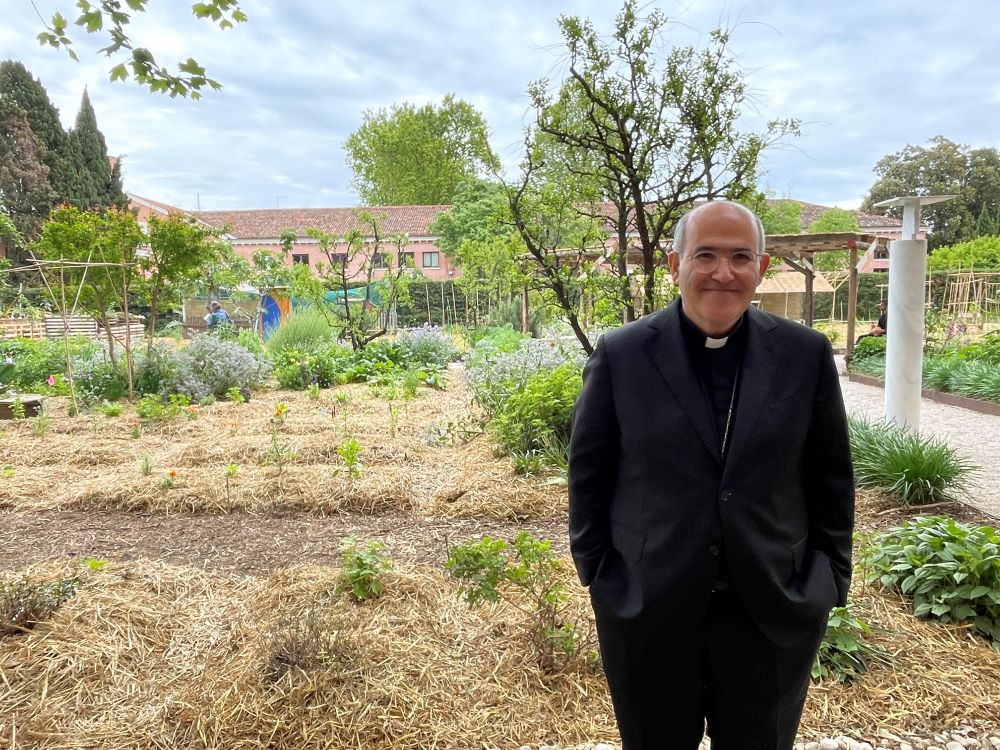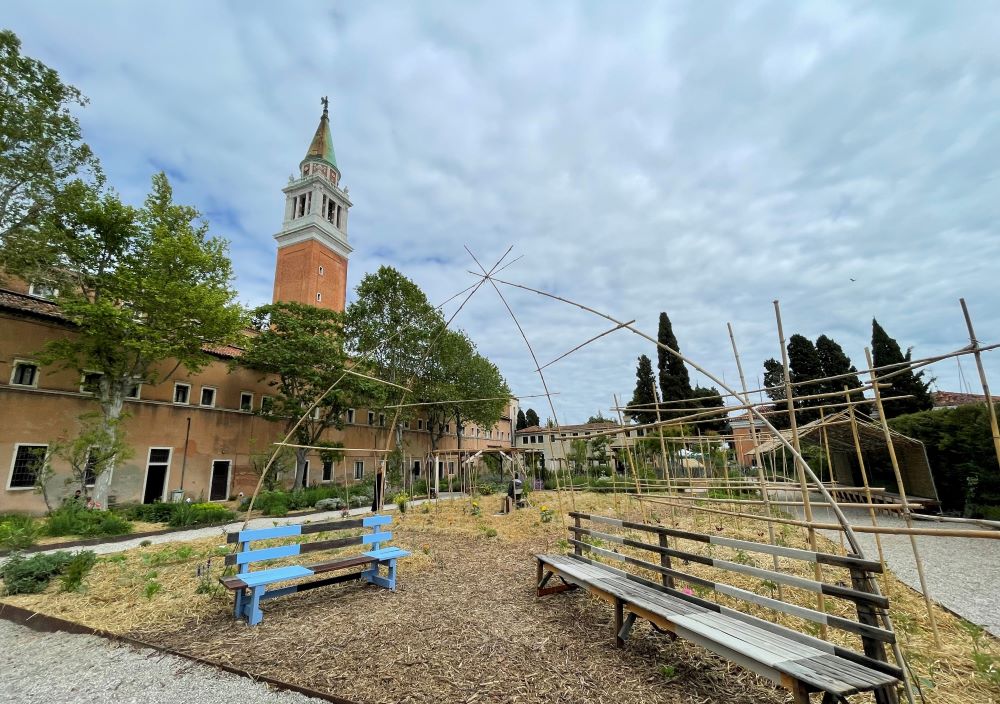
At the courtyard of the "Social Friendship: Meeting in the Garden" exhibition at the Venice Biennale of Architecture, roosters crow, cats roam freely among the grounds' more than 100 plants, and neighboring young people stop by to rest or read on a garden bench or to help collect the urban vegetable harvest. (Courtesy of the Vatican's Dicastery for Culture and Education)
In Pope Francis' 2015 ecological encyclical, Laudato Si', he writes that architecture should "connect, relate and favor the recognition of others" — a vision that is given concrete expression at the newly opened Vatican pavilion at Venice's Biennale of Architecture.
Located inside the courtyard of the city's renowned Monastery of San Giorgio, on the island that bears the same name, it's possible to hear elements of the exhibition before seeing it. Roosters crow, cats roam freely among the grounds' more than 100 plants, and neighboring young people stop by to rest or read on a garden bench or to help collect the urban vegetable harvest.
Just outside the monastery is one of the world's most celebrated waterways, but inside it's a cloister of calm.
"Social Friendship: Meeting in the Garden," the Holy See's exhibit at the 18th International Architecture Biennale officially opened May 20 and will run through Nov. 26. The Biennale's theme is "The Laboratory of the Future," where countries of the world propose "architectural solutions to contemporary societal, humanistic, and technological issues."
While the city of Venice is run amok with tourists — with more than 100,000 passing through each day during peak travel season — the Vatican's exhibition begins by taking visitors back to a time not so long ago when daily life was defined by isolation.
On March 27, 2020, just a few weeks into the COVID-19 pandemic, Pope Francis entered a rainy St. Peter's Square alone and prayed that this time of forced solitude might lead to a reawakening of solidarity.
Three years later, the Vatican's contribution to the Biennale offers one example of how architecture and public spaces might contribute to that goal through an inviting, sustainable garden that both practically and philosophically underscores the need for social fraternity.

Portuguese Cardinal José Tolentino Calaça de Mendonça, head of the Vatican's Dicastery for Culture and Education, stands in the garden at the Vatican's exhibition at the Venice Biennale of Architecture. (EarthBeat photo/Christopher White)
According to Portuguese Cardinal José Tolentino Calaça de Mendonça, head of the Vatican's Dicastery for Culture and Education, the exhibition illustrates the "change of mentality" or "conversion" that is needed to achieve that end.
"The world will have a future only if we will find in each other and new forms of relationships among people a new way of living and of inhabiting this common home," he told Earthbeat.
Designed by curator Roberto Cremascoli, the exhibition space seeks to synthesize Francis' teachings found in his two hallmark encyclicals, Laudato Si' (2015) and Fratelli Tutti (2020), asking the question: how are we to "take care of the planet as we care for ourselves and celebrate the culture of encounter?"
Upon entering the exhibition space, visitors greet celebrated Portuguese architect Álvaro Siza's "O Encontro" geometic figures in various positions of open arms, embrace or kneeling, all leading the way to the courtyard.
Inside the vibrant courtyard, guests encounter a laboratory for Laudato Si' in action: a chicken coop, a garden grown from seeds from the four corners of the earth whose produce is made available to individuals and organizations in need, an active compost station for locals to utilize, a wooden pergola with benches for relaxation. All of it was built using wood from reused materials from the Veneto region.

The Holy See's exhibit at the 18th International Architecture Biennale opened May 20 and will run through Nov. 26. Shown is the courtyard of "Social Friendship: Meeting in the Garden" at the Monastery of San Giorgio, on the island of San Giorgio, Venice. (EarthBeat photo/Christopher White)
When plans were first underway for the exhibition, the Vatican specifically engaged the Milan-based Studio Albori, which has a long history of sustainable architectural design.
"To reuse everything is our philosophy," architect Emanuele Almagioni told Earthbeat. "For us, architecture is always this: sharing and using actual materials that already exist."
Throughout Laudato Si' the pope emphasizes that "everything is connected" — that social problems and human relations cannot be understood outside or apart from their ecosystems or natural environments.
For Cremascoli, the exhibition's backdrop of Venice underscores this reality: a city with a strategic geographic location between Europe and the Middle East, connecting a range of peoples and places. For the curator, it is also a city of constant contradiction, evidencing the need for experimentation and constant adaptation: a city without automobiles and their pollution, but that today is threatened by human traffic.
Advertisement
How does one foster connection and encounter in this environment?
Part of his response at the Biennale is to draw connections between the land and its inhabitants by creating an exhibition that invites local residents into the "Social Friendship" garden to both work the land and reap its harvest — together.
"The proposal of this pavilion of the Holy See is to seek an experience of a way of life where inclusion becomes a reality," said Cardinal Tolentino.
And this exhibition, he says, is a living testimony of the pope's message in Laudato Si' that "man is not the despotic center of the world, but is the sensible curator of a living system."








